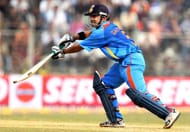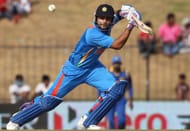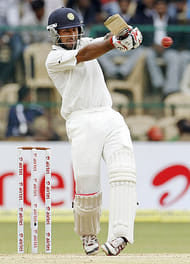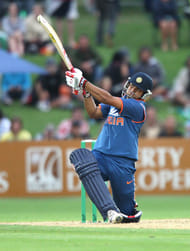Now that the dust has settled on Sachin Tendulkar’s retirement decision, it is time to shake ourselves out of our torpor and come face to face with the realization that, two months before an impending South Africa tour, we do not have an alternative for Number Four. It may be too early to predict who will claim the coveted spot but we might as well take a look at the usual (and not so usual) suspects.
Virender Sehwag: The most popular name doing the rounds, Sehwag has left no stone unturned to declare his intentions of not just returning to the Indian team but taking up the Number Four position. On paper, there is merit to his claims – the only person who can be a like-for-like replacement for Tendulkar is Sehwag. He is probably also the only Indian batsman (apart from MS Dhoni) who can shrug off the burden of Tendulkar’s aura as if it were a fly on his shoulder and go ahead with the job at hand.
The problems lie deeper. While he can match Tendulkar’s potential, he does not even have an iota of his temperament. Coming back to the middle order might seem as a cinch for him as he would get a chance to bat against the spinners and a relatively out-of-breath pace attack. But spin has often been the Trojan horse for Sehwag – how often has he thrown it away against a spinner who has just come in to bowl? The same traits were on display in the recent series against West Indies A where Sehwag failed to do anything of note. Add to that the fact that he does not have a Test century outside India in close to six years. If he wants to prove anything else before December comes, he does not have too much time left.
Gautam Gambhir: It might come across a surprise to many but in my opinion Gambhir could be the best option to fill up the gaping hole left by Tendulkar. Gambhir is the exact anti-thesis of Sehwag (possibly the reason why they made such a successful pair over the years) but you would have to search hard to find someone among his contemporaries who is as focussed on his batting as he is. Sehwag’s carefree approach often spells his doom; one cannot say the same about Gambhir.
There will be critics – after all, Gambhir has spent the greater part of his cricketing life as an opener. But if a middle-order batsman can open the batting and become one of the modern greats of the cricketing world, why can we not have the opposite? In any case, it is an easier job than facing the new cherry first up. Besides, India would any day prefer to take an old warhorse to battle in South Africa rather than an inexperienced greenhorn.
Virat Kohli: Unlike the above two, for Kohli it is not about coming back to the Indian side. It is, both literally and figuratively, about taking a step up. Ever since Sehwag’s star has faded, Virat Kohli has become the new poster boy of the Indian top order. He has the strokes, the flourish and the temperament – 16 centuries, most of them match-winning, in his relatively short ODI career tells the story. After a rough initiation, Kohli has started to show his potential in Test matches too. In an ideal world, he would slot in right into Tendulkar’s boots. The problems though lie somewhere else.
Moving Kohli up the order does not solve the selector’s problem for India; they would still have to find a new Number Five. Moreover, unlike in ODIs, Kohli has taken his time to find his groove in Test cricket. Unsettling him from his current position and that too against the world’s best bowling attack might not be the best idea. Nevertheless, Kohli’s potential and promise will continue to tantalise the selectors till they come to a final decision.
Cheteshwar Pujara: Easily the biggest success story of Indian Test cricket after the debacles of England and Australia, Che Po has made Rahul Dravid’s retirement seem not so disconcerting as it should be. Ever since coming back to the Indian team after a horrific injury curtailed a year of his international career, Pujara has soared up and up with double centuries against England and Australia, three first class triple centuries and the captaincy of the A side. It wouldn’t be then too much of an overstatement to say that, on current form, Pujara is the best Test batsman in the side and therefore a worthy contender for Number Four.
But I would bet my next month’s salary against that happening. Moving Pujara to Number Four would not just threaten the golden goose’s life but leave his nest empty. India has a new set of openers who have just batted together for one match; they would not risk a new Number Three in seaming conditions. Besides that, Pujara has always batted at Number Three: his unobtrusive personality and uncomplicated style suits the position. Add to that the fact that Pujara is largely untested in overseas conditions – two below-average Test match outings in South Africa the last time India toured there – and he would prefer anything else to a shake-up from his batting position.
Suresh Raina: Most of you would be surprised seeing his name ahead of Rohit Sharma’s name in this list. But, to be fair to him, Raina has made more of the chances given to him that Rohit has over the years – a one-off century on a listless ODI pitch is far from proving a lot about yourself.
It is true that most of his successes have been in limited overs cricket. It is true that he has been found wanting against the short ball more than once – something he would have to prepare himself for if given a chance to go to South Africa. But Raina has often bounced back when his critics were least expecting it.
After an aborted start to his international career at the age of 19, Raina came back into the team in 2008 and established himself as a key lynchpin in the middle order. Two years later, he was captaining the team in Zimbabwe in the absence of MS Dhoni – soon after becoming the first Indian to score a century in a T20 international. The same year he got a chance to make his Test debut after playing close to 100 ODIs – a record which has since been taken over by Rohit Sharma. He made the best of the opportunity by scoring 120 against Sri Lanka in their backyard.
In the 2011 World Cup, India had to choose one from Virat Kohli (not yet a superstar) and Yusuf Pathan (fresh from his belligerent heroics in South Africa) and they ended up dropping Raina for the league phase matches. After Yusuf’s continued failure, they got Raina back for the quarter-finals against Australia where he made an immediate impact.
Since then though, the script has unravelled. The vice-captain‘s cap has been passed over to Virat Kohli – in a twist of fate, Raina played under Kohli in the recent Zimbabwe series. It was Kohli again who took up Raina’s Number Six slot in the Test match lineup in Australia after a horror tour of England. Laxman’s retirement provided a foot in the door for Raina but Yuvraj Singh’s emotional return to the Indian team followed by Ravindra Jadeja’s resurgence as a bowling all-rounder slammed the door back on his face.
But, like Dinesh Karthik, Raina has always grabbed an opportunity by the scruff of its neck given a chance. Again like Karthik, his sole fault has been to let it slip away too soon. This time might be his best (and last) chance – he should be prepared to hold on even with the skin of his teeth.
Notable mentions
Ajinkya Rahane: Had to wait long for his Test debut but could not make much of it when it came in the fourth Test against Australia in the wake of Shikhar Dhawan’s injury. Has done enough though otherwise to warrant a second try.
Subramaniam Badrinath: A long time servant and stalwart of Indian domestic cricket, Badri has got his chances but hasn’t been able to make the most of it. At 33, a recall seems unlikely unless the selectors give his experience some extra points.
Manoj Tiwary: Like Rahane, another sufferer of the selectors’ Rohit Sharma syndrome as well as extreme cases of ill-fortune. Has an ODI century and a four wicket haul in the clutch of ODIs played over the last couple of years or so but yet to be considered for greater honours.
M S Dhoni: A left-field decision which could turn out to be brilliant in hind-sight. Dhoni himself might not been too keen to the fact given his wicket-keeping and captaincy duties. Also leaves the selectors with the burden of finding a suitable Number Six/Seven.
Rohit Sharma: The selectors’ favourite. Currently experiencing a second wind in his ODI career but is he good enough for a Test match call-up in South Africa?
Brand-new app in a brand-new avatar! Download Cric Rocket for fast cricket scores, rocket flicks, super notifications and much more!




